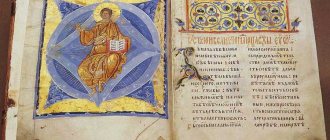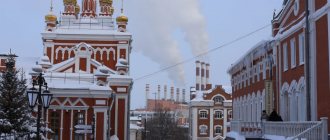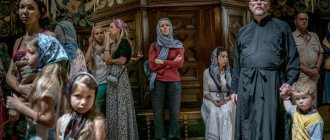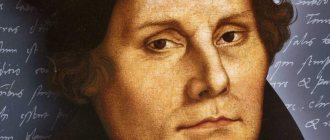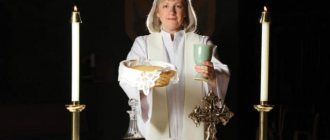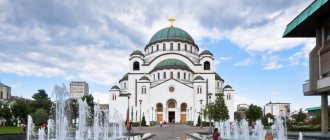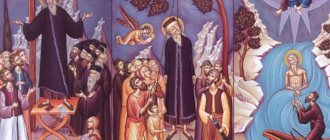Little is known about the secret monks. Often only relatives learned about a person’s tonsure after his death. The inner, hidden part of life remained undisclosed.
Secret monasticism appeared in the Soviet Union as a reaction to the actions of the atheistic authorities. The persecuted Church did not cease its activities, but went into an illegal position - once again the words of the Lord came true: “I will build My Church and the gates of hell will not prevail against it.”
Secret monks became an adornment of the Church of Christ at that difficult time, its joy and consolation. They survived many years of exile, but their difficult life strengthened their Christian faith. Elder Schema-Archimandrite Jonah (Storchak) said: “The Soviet government is good. She made many saints.”
Secret monks in pre-revolutionary times
In the biographies of some elders and ascetics of the 19th century, there are references to secret monks.
Secret monks are people who live in the world and hide their monastic identity.
They secretly tonsured people who could not live in a monastery, but aspired to monasticism and could fulfill monastic vows. Such tonsures were rare. For example, the writer Konstantin Leontiev lived for some time in Optina Pustyn. He communicated with Rev. Ambrose, and just like St. Ambrose made a vow to become a monk. His life developed in such a way that he lived all his life in the world and wrote. At the end of his life he took secret tonsure with the name Clement.
Konstantin Leontyev
The Sixth Ecumenical Council dealt with the problems of organizing monastic life - at that time (7th century) many vagabond monks appeared, walking from city to city and confusing the people. It was decided to subordinate them to diocesan administrations and organize cenobitic monasteries in order to separate them from the world.
There are still two types of structure of monastic life - Kellyot and cenobitic. The Kellyot method is characteristic mainly of Athos.
"three types of monastic situation."
First situation
- This is an already established old monastery. This is what is usually meant by the words “becoming a monk.” Becoming a monk means for many people entering a monastery. And Father Seraphim writes that spiritual fruit in such a monastery is achieved through the suffering associated with staying in such a place, as well as through continuous connection with the past. Such a monastery, as it were, pulls a thread from the past, people join it, and as a result of this they get spiritual fruit, plus the suffering associated with staying in such a monastery.
Here Father Seraphim speaks about monasteries in the tradition of the Church Abroad. In August of this year, just a month ago, Abbess Alexandra from ROCOR(A) gave a report on the monasteries of the Church Abroad. She visited all the historical monasteries of the ROCOR. She describes four convents of the Church Abroad and the main monastery of the ROCOR, Jordanville. Her report carefully examines the routine of life and worship in such monasteries, but nowhere in the entire report is it mentioned, even briefly, the main activity of a monk - the Jesus Prayer. Maybe she has her own opinion, of course, but I also heard from other eyewitnesses who visited these monasteries that the main efforts there are aimed at receiving pilgrims and maintaining ancient buildings. Usually these monasteries have quite large real estate, which is difficult to maintain; the monks work for this, and I have never heard of the Jesus Prayer in the monasteries of the Church Abroad.
Although there is a slightly different monastery, different in spirit, it is located in Boston. In the USA there are even several such monasteries in the Church that is friendly to us, where they have a completely different attitude towards the Jesus Prayer, but they are all English-speaking, in a slightly different, Greek, tradition, but such monasteries do exist.
The second type of "monastic situation"
about which Father Seraphim writes, arises when a person begins to strive himself, according to his understanding of the examples of the great ascetics of the past. Father Seraphim explains that this is the most dangerous of all the monastic paths open today. And it's clear why. Father Seraphim gives many reasons why this is dangerous, and explains what qualities a person must have - an almost impossible combination of qualities - in order to survive like this. And, besides, such a hermitage in Russia is also a physically dangerous path. If in America, where Father Seraphim lived, you can fence off the territory, write “private territory”, and it will be quite well guarded, then in Russia all this is much more dangerous.
But there is one more thing that did not exist in the time of Father Seraphim, which is both good and evil. These are modern means of communication. If such an ascetic really tries not to use the Internet, then he chooses the second type described by Father Seraphim with all its dangers. If he uses the Internet, then he approaches the third type, because he has some like-minded people with whom he can communicate, and then he gets what Father Seraphim called the third type of “monastic situation.”
The third type of “monastic situation”
occurs when a group of several people begins to struggle, supporting each other. This case is very common for true Orthodoxy in Russia. There are parishes here, they are either apartment-type or churches (but the TOC managed to retain quite a few churches), in these communities there are people trying to live monastically, they usually stick together, and later one of them receives tonsure. Thus, at the parish, a small monastic community is obtained, usually of an urban type, which is often called monasticism in the world.
There are many problems here, but four lie on the surface. The first is how to keep in shape, the second is how to maintain some isolation from the world, the third problem of female monasticism is how to deal with lust (this is the other side of the problem of obedience), and the fourth problem is collective pride.
Monasticism in the world
In the post-Soviet space, the revival of monasticism began in 1988. During the years of persecution, the continuity of traditions characteristic of Russian monasticism was lost. Monasteries were revived out of sheer enthusiasm; the new monks lacked spiritual experience. To protect them from falling, the clergy did not bless the singular residence. There is no need for secret tonsure, since now there is no persecution and danger to life. It’s another matter for monks in the world. It happens that another person has strived for monasticism all his life, but for objective reasons he was unable to take monastic vows, and life in a monastic community is no longer possible. It is these pious elders and old women who are tonsured by the ruling bishop, and they continue to live in peace.
Schema-Archimandrite Jonah (Storchak)
For example, in Ukraine, in the Vinnytsia region, the parish priest, Archpriest Peter Storchak, and his wife, took monasticism in his old age. With God's help, Archimandrite Pimen built a large cathedral in his native town, organized a sisterhood, which over time received the status of a convent. Shortly before his death, Father Pimen was tonsured into the schema with the name Jonah. Father was the spiritual child of St. Amphilochius of Pochaev, and became a spiritual father for many laity and clergy. Schema-Archimandrite Jonah (Storchak) used his example to prove the truth of the words of Seraphim of Sarov, “Save yourself, and thousands around you will be saved.”
Monasticism in the modern world. Monk as a citizen of the Kingdom of Heaven on earth
Bishop of Borisov Veniamin
Our Lord Jesus Christ as the “equivalent seal” [1] of the Father, “the radiance of glory and the image of the Hypostasis” of the Father (see Heb. 1:3) revealed to the world the human ideal, the icon of the true man: the way God intended him. Throughout His entire life on earth, Jesus Christ set an example that we must follow in order to become worthy citizens of the Kingdom of Heaven: “Whoever serves Me, let him follow Me; and where I am, there will my servant also be” (John 12:26). To follow Christ means to fulfill the will of God, which is revealed to us in the word of God: “I no longer call you servants, for the servant does not know what his master is doing; but I have called you friends, because I have told you everything that I heard from My Father” (John 15:15).
Thus, the main task of all Christians, including monastics, is to fulfill the will of God in their lives. What then is the specificity of monastic feat?
Saint Ignatius (Brianchaninov) says: “The purpose of monastic life is not only to achieve salvation, but, above all, to achieve Christian perfection[2].” That is, it is natural for a monk to strive to achieve Christian perfection, while a pious layman, as a rule, is satisfied with the idea of saving his soul.
Monks are those Christians who, repeating and fulfilling the words of the Apostle, do not want to know anything in the world except Jesus Christ and this Crucified One; for them the world was crucified and they for the world. “Remember the Lord Jesus. Crucified under Pontius Pilate,” these words of the Apostle Paul to his disciple and child of faith and obedience Timothy sound like an eternal commandment to Christians (cf. 2 Tim. 2:8; 1 Tim. 6:13)[3].
Monasticism is an integral part of the Church; it arose along with the emergence of the Church. According to Metropolitan Hierotheos (Vlahos), this is a prophetic, apostolic and martyr’s life. Every true monk, according to Orthodox Church Tradition, is a prophet, apostle and martyr for Christ. He lives in Christ, testifying to the new life that the Lord brought into the world, and is ready to endure martyrdom for Christ. In addition, a true monk sets an example of spiritual warfare for cleansing the heart and soul and repelling the attacks of the devil.
A monastery is a sacred place, an abode of virtue. The purpose of monastic life, as St. Ignatius (Brianchaninov) says, is not only to achieve salvation, but, above all, to achieve Christian perfection.”[4] Monasticism is precisely one of the forms of Orthodox asceticism, most adequately adapted to the acquisition of Christian perfection, which is expressed in a state of dispassion.[5] Therefore, monasticism is a light for the laity, a pointer on the path of spiritual improvement[6]. The idea of dispassion, or union, is the main ultimate goal of monastic achievement. The Venerable Seraphim of Sarov said: “The true goal of our Christian life is to acquire the Holy Spirit of God”[7].
The acquisition of the Holy Spirit or dispassion, unification, is achieved only through life according to the Gospel commandments. Therefore, a monk must constantly read—and not just read, but carefully study in the light of patristic tradition—the Gospel. Let us turn again to the statements of the Venerable Seraphim of Sarov and, in particular, about the importance of the word of God in the matter of our salvation: “Most of all, we must practice reading the New Testament and the Psalter... From this comes enlightenment in the mind, which is changed by the Divine change.”[8] According to the words of St. Seraphim: “All the saints... were subservient to us, but by fulfilling the commandments of Christ exactly with all their souls, they achieved perfection and salvation, found grace, were granted various gifts of the Holy Spirit and inherited the Kingdom of Heaven...”[9]
Other holy fathers also testify that monasticism is, first of all, the fulfillment of the Gospel commandments. Thus, in the Fatherland, compiled by Saint Ignatius (Brianchaninov), we find the words of the Monk John Kolov: “Forcing oneself to obey every commandment of God is a distinctive feature of a monk. He who lives like this is a monk.”[10]
Saint Ignatius (Brianchaninov) himself wrote about this: “Monasticism is nothing more than an obligation to accurately fulfill the Gospel commandments... Monastic life is nothing more than life according to the Gospel commandments, wherever it is carried out - in crowds or in the deepest desert.”[11]
It is characteristic that Saint Ignatius begins his teaching on the life of a monk according to the Gospel with the following categorical statement: “A monk, from the very moment he enters a monastery, must engage in reading the Holy Gospel with all possible care and attention, study it so that the Gospel is always before his memory, and at every moral step, for every action, for every thought, he had in his memory the ready instruction of the Gospel.”[12] It is interesting that we find almost the same words in the famous “father of eastern monasticism” St. Anthony the Great: “...Whatever you do, have evidence of it in the Scriptures...”[13] Nowadays there is a lot of talk about the need for the education of monastics, and this is certainly true. According to patristic tradition, the main science for the inhabitants of our monasteries should consist, first of all, in a careful study of the New Testament and the works of the Holy Fathers. It would not be amiss to note that the founder of cenobitic monasticism, the Monk Pachomius the Great, attached great importance to this most important monastic work. A newcomer to his monastery first of all sat down to memorize the Psalter and something from the Gospel. This was a test of his perseverance and love for the word of God[14].
In our time, unfortunately, paramount importance is primarily given to the external structure of the monastery, and not to the internal life of each brother or sister. Often monastics, due to excessive overload with obediences, do not have enough time not only to study the New Testament and the Holy Fathers, but even to read a chapter from the Gospel. This is justified by such a common phrase: “Obedience is higher than fasting and prayer.” But obedience (here we mean work for the good of the monastery) should not replace prayer, fasting, and in general everything for which a person came to the monastery!
In monastic work, as in any other work, a correct hierarchy of values must be built. Back in the 14th century, Rev. Gregory of Sinaite complained that he walked around the entire Mount Athos and, among thousands of monks, found only three vessels of grace who had some understanding of “smart work.”[15] Analyzing the causes of the catastrophe that befell our Fatherland at the beginning of the twentieth century, including Russian monasticism, Archpriest John Zhuravsky wrote: “The monasteries—these guardians of the “smart light”—collapsed because monasticism itself destroyed the foundation of the monasteries: it abandoned “smart work.” Abandoning “smart work” and the infatuation of monasteries in recent times with the acquisition of external contentment and glory, infatuation with external decorum and pomp - was a grave sin and a daring violation of the vows given by monasticism.”[16]
What is the peculiarity of modern monasteries in contrast to at least pre-revolutionary ones, not to mention the monasticism of ancient times? Monastic continuity has been disrupted, mentors in spiritual life have become scarce, and new ones have not yet emerged. Of course, we now have an abundance of spiritual literature, but we cannot learn the correct monastic life from books alone. Book knowledge, according to the words of Archimandrite Lazar (Abashidze), cannot be applied practically correctly by many. How today specifically in the conditions of our monasteries to fast, pray, work, strive, how to live in general - the answer to these questions, precise and definite, will not be found in any book. This can only be established through long experience, going through many sorrows, falls and uprisings.
In the middle of the 19th century, Saint Ignatius (Brianchaninov) wrote: “Weakened Christianity prepares and supplies its state with weak monks. Nowadays the entry of a virgin into a monastery is the greatest rarity! Nowadays, the entry of a person who has not acquired vicious skills is a rarity! Nowadays, the entry of someone who has preserved unspoiled health and is capable of monastic exploits is a rarity!”[17] Further, the saint continues: “The weakest, those damaged in body and soul enter most;... those who are satiated with sensual pleasures, who have acquired a taste for all the temptations with which the world is now filled, enter; they enter with deep-rooted vicious habits, with a dull conscience, killed by the previous way of life.”[18] What can we say about our time?
When the initial, invoking grace, a kind of spiritual (mostly spiritual) enthusiasm gradually departs from a novice who has entered a modern monastery, he experiences all the difficulties and sorrows of monastic life. Sorrows for which he is often completely unprepared, because his entire previous life was an escape from these sorrows.
Meanwhile, many holy fathers spoke about the need (especially for monastics) of sorrows and labors to acquire the grace of God. From St. Nile of Sinai we read: “The Lord does not grant divine spiritual grace to everyone, but only to those who, in labor, in self-exhaustion, with shedding sweat, ask for it day and night.”[19] In another place the saint asks in amazement: “How do you wish and pray to God to grant you some kind of spiritual grace without labor and sorrow?”[20]
Hence, it is very important to explain to the newcomer who has just entered the monastery that what awaits him is not the enjoyment of high spiritual states, not the intoxication of the gifts of Divine grace, but a serious, exhausting, bloody struggle with his own passions and lusts (see Gal. 5:24). But it’s not enough to explain in words; you need to give a person the opportunity to verify this. Therefore, one should not rush into tonsure, and perhaps even with simply putting on a cassock.
The trouble is, if the monastery authorities rush to tonsure an unprepared person, there may be one more broken life... But, unfortunately, it also happens that monks who have spent many years in the monastery “break down.” They experience relaxation, carelessness, and indifference to everything spiritual. Why is that? One of the main reasons: there is not enough patience, which alone can pull out of the abyss of despondency that drags down a monk and whom in the monastery, according to the word of St. Ambrose Optinsky needs “not a cart, but a whole convoy.”
As for the rulers, their task is to create such conditions in the monastery that would help (and not hinder, as unfortunately happens with us) the monastics to carry out their lives according to the Gospel, in the feat of prayer, the “life of fasting” (ascetic ). Saint Ignatius (Brianchaninov) compares a monk to a greenhouse flower, which requires special care[21]. The rulers must with the greatest care create and then constantly maintain a kind of “greenhouse conditions” in the monastery so that every soul in the monastery grows spiritually and does not perish from trampling on the patristic rules of monastic life.
Much can be said about ways to revive modern monasticism, but let’s say the main thing. So that our monasticism has a future - and a good future! - it is necessary to build it on a strong foundation, and not on sand. Such a foundation is the word of God and the patristic heritage, which alone can lead us away from a material, carnal, perishing life.
Monasticism must not be used for purposes that are far from its true purpose. We mean such - alas! - very familiar phenomena such as the actual transformation of monasteries into tourist or commercial centers, bishops' metochions, an appendage to theological schools and the like, where monks often serve as service personnel. If we honestly do not talk about this, but hide the existing problems like an ostrich and do not look for ways to resolve them, then there can be no talk of any revival of monasticism.
But monasteries, according to the words of the Hieromartyr Archpriest John Vostorgov, “are like reserve reservoirs of living water of religious inspiration; they nourish and moisten the parched deserts of the spirit of worldly life, they give life-giving and saving moisture to thirsty souls.”[22]
“The renewal and revival of the life of our peoples lies in the strength of the life of the spirit,” the saint continues, “and not in those external reforms of the state and social system on which so many hopes are now pinned: the best medicine will not help a corpse.” It’s amazing how relevant these words spoken a hundred years ago sound.
Therefore, it is so necessary for us to see a clear perspective for the development of our modern monasticism. And this prospect is still far from optimistic. It is necessary to change something, but change it in the right - patristic - direction, otherwise we can change everything so much that “there will be the last... a pot of the first” (cf. Matt. 12:45). “In order to achieve a good end, it is necessary,” as the Monk Moses, the hermit of Egypt, said to Saint Cassian, “to have in mind a goal towards which to strive constantly and with all your might. For monks, this goal, even here on earth, should be purity of heart, and the means to achieve it is the fulfillment of the commandments of the Gospel” in external and internal life.
The path is shown to us - from the external to the internal: to attention to thoughts and to undistracted, unceasing prayer. Whoever is inside is on the right path. For only the inner life, which begins with attention to one’s actions and thoughts, is truly Christian life. This is what all the fathers testify[23]. “The essence of monasticism is in smart work, and the essence of Christianity is in monasticism. Without smart doing there is no monasticism”[24].
So, modern monastic life, despite all the difficulties and imperfections inherent in it, in essence, as at all times, is not a new form of Christianity, but truly Christian life in the Spirit, it is following the example of the prophets, apostles and martyrs of the early Church, it is whole life according to the commandments of Christ”[25], the new life that Christ, having become man, brought into the world, life in repentance, purification of the heart and use of the commandments of God.
Literature:
1. Testaments to monks. Teachings of Archpriest John Vostorgov on monasticism. M.: Rule of Faith, 1997.
2. Saint Ignatius (Brianchaninov). Symphony based on the works of St. Ignatius, Bishop of the Caucasus and Black Sea: With subject and name indexes. - M.: Sretensky Monastery Publishing House, 2001.
3. Metropolitan Hierotheos (Vlahos). Saint Gregory Palamas as a saint. STSL, 2011.
4. Seraphim of Sarov. The life of Elder Seraphim, Sarov monastery, hieromonk, desert dweller and recluse. — Ed. 2nd, add. — Klin: Christian Life Foundation, 2001.
5. Seraphim of Sarov. The life of our venerable and God-bearing father Seraphim, the Wonderworker of Sarov. — Ed. 3rd. - M.: Publishing Council of the Russian Orthodox Church, 2003.
6. Saint Ignatius (Brianchaninov). Complete works of St. Ignatius Brianchaninov: in eight volumes / Comp. and general ed. A. N. Strizheva. - M.: “Palomnik”, 2004. - T. I–VII.
7. Philokalia: in 5 volumes - Ed. reprint. - M.: Holy Trinity Sergius Lavra, 1992.
8. Nikon (Gorokhov), hierodeacon. Entry into monasticism and exit from it: Holy Fathers and modern devotees of piety about monasticism // Sretensky Monastery. Sretensky Theological Seminary [Electronic resource]. - 2010. - Access mode: https://www.pravoslavie.ru/-sm/31019.htm#_ftnref15. — Access date: 05/26/2010.
9. Hieromonk Sergei (Sitikov). The Mystery of the Kingdom of God, or the Forgotten Path of True Knowledge of God. From the library of Elder John Zhuravsky. Chapter 2. M.: Siberian Blagozvonnitsa, 2009.
10. Neil of Sinai. Creations of our venerable father Nil, the ascetic of Sinai. - M., 1858.
[1] Missal. - M.: Publishing Council of the Russian Orthodox Church, 2008. - P. 231.
[2] Ignatius (Brianchaninov). Symphony based on the works of St. Ignatius, Bishop of the Caucasus and Black Sea: With subject and name indexes. - M.: Sretensky Monastery Publishing House, 2001. - P. 149.
[3] Testaments to monks. Teachings of Archpriest John Vostorgov on monasticism. Conversation 3: Monasticism. M.: Rule of Faith, 1997. pp. 55–43.
[4] Ignatius (Brianchaninov). Symphony based on the works of St. Ignatius, Bishop of the Caucasus and Black Sea: With subject and name indexes. -M.: Sretensky Monastery Publishing House, 2001. - P. 149.
[5] Testaments to monks. Teachings of Archpriest John Vostorgov on monasticism. Conversation 1: Asceticism and monasticism. M.: Rule of Faith, 1997. P. 25.
[6] Metropolitan Hierotheos (Vlahos). Saint Gregory Palamas as a saint. Chapter 5. STSL, 2011, pp. 124–125.
[7] Seraphim of Sarov. The life of Elder Seraphim, Sarov monastery, hieromonk, desert dweller and recluse. — Ed. 2nd, add. - Klin: Christian Life Foundation, 2001. - P. 423.
[8] Seraphim of Sarov. The life of our venerable and God-bearing father Seraphim, the Wonderworker of Sarov. — Ed. 3rd. - M.: Publishing Council of the Russian Orthodox Church, 2003. - P. 440.
[9] Life of Elder Seraphim, Sarov monastery hieromonk, desert dweller and recluse. P. 91.
[10] Saint Ignatius (Brianchaninov). Complete works of St. Ignatius Brianchaninov: in eight volumes / Comp. and general ed. A. N. Strizheva. - M.: “Palomnik”, 2004. - T. VI. — Fatherland: selected sayings of holy monks and stories from their lives. — P. 253.
[11] Saint Ignatius (Brianchaninov). Complete works of St. Ignatius Brianchaninov: in eight volumes / Comp. and general ed. A. N. Strizheva. - M.: “Pilgrim”, 2003. - T. V. - Offering to modern monasticism. — P. 366.
[12] Ibid. P. 31.
[13] Philokalia: in 5 volumes - Ed. reprint. - M.: Holy Trinity Sergius Lavra, 1992. - T. 1. - P. 119.
[14] Nikon (Gorokhov), hierodeacon. Entry into monasticism and exit from it: Holy Fathers and modern devotees of piety about monasticism // Sretensky Monastery. Sretensky Theological Seminary [Electronic resource]. - 2010. - Access mode: https://www.pravoslavie.ru/-sm/31019.htm#_ftnref15. — Access date: 05/26/2010.
[15] Saint Ignatius (Brianchaninov). Complete works of St. Ignatius Brianchaninov: in eight volumes / Comp. and general ed. A. N. Strizheva. - M.: “Palomnik”, 2003. - T. II. — Ascetic experiences. — P. 300.
[16] Hieromonk Sergei (Sitikov). The Mystery of the Kingdom of God, or the Forgotten Path of True Knowledge of God. From the library of Elder John Zhuravsky. Chapter 2. M.: Siberian Blagozvonnitsa, 2009. pp. 37–38.
[17] Ignatius (Brianchaninov). Complete collection of the works of St. Ignatius (Brianchaninov): In 8 volumes / Comp. and general ed. — A. N. Strizhev. - M.: Pilgrim, 2006. - T. I. - Ascetic experiences. — pp. 443–444.
[18] Ibid. P. 444.
[19] Neil of Sinai. Creations of our venerable father Nil, the ascetic of Sinai. - M., 1858. - Part 3. - P. 361.
[20] Neil of Sinai. Creations of our venerable father Nil, the ascetic of Sinai. - M., 1858. - Part 2. - P. 395.
[21] See Saint Ignatius (Brianchaninov). An offering to modern monasticism. P. 27.
[22] Testaments to monks. Teachings of Archpriest John Vostorgov on monasticism. Conversation 1: Asceticism and monasticism. M.: Rule of Faith, 1997. pp. 22–23.
[23] Hieromonk Sergei (Sitikov). The Mystery of the Kingdom of God, or the Forgotten Path of True Knowledge of God. From the library of Elder John Zhuravsky. Chapter 2. M.: Siberian Blagozvonnitsa, 2009. pp. 46–47.
[24] Ibid. Chapter 6. P. 52.
[25] Metropolitan Hierotheos (Vlahos). Saint Gregory Palamas as a saint. Chapter 5. STSL, 2011, pp. 101–102.
28.01.2013
Social media
Decree of 1918 - the beginning of persecution
On January 20, 1918, at a meeting of the Council of People's Commissars, the bill “Decree on Freedom of Conscience, Church and Religious Societies” was considered and adopted, significantly supplemented by V. Ulyanov (Lenin). On February 26, the decree was published in the Collection of Legislation and Orders of the Workers' and Peasants' Government under the title “On the separation of church from state and school from church.” This document became the legislative basis for the destruction of a huge part of the life of pre-revolutionary man; it was a declaration of war on the Church. Church communities were equated to private organizations and were deprived of the status of a legal entity and the rights to own property. The property of religious communities was subject to nationalization.
Procession of the Cross in defense of the Church 1918
The monasteries that suffered most from the decree of 1918 were the first among all religious communities to be outlawed. The ban on the right to own property and the nationalization of church property gave the authorities the opportunity to liquidate monasteries on a legal basis. For some time this process was delayed by the transformation of some monasteries into agricultural cooperatives. In 1919, the People's Commissariat of Agriculture and the People's Commissariat of Justice developed instructions according to which monks and clergy could not be members of labor artels, as persons deprived of voting rights. Most of the monasteries, hiding behind the guise of agricultural organizations, were dispersed in 1919-1921. One of these communities is the Zakharyevskaya commune named after N. Krupskaya.
Mother Frosya
The atheists among the people also contributed to the closure of the monasteries. One of the Diveyevo nuns, Mother Euphrosyne, recalls how their monastery was robbed by drunken peasants.
Historical information
Followers of Jesus Christ spread his knowledge throughout the globe. People who believed them began to adhere to an ascetic lifestyle. A little later, a separate category of believers begins to unite in small groups to serve God.
Find out what awaits you today - Horoscope for today for all zodiac signs
Where and when exactly monastic tonsure arose - history has not conveyed to this day. What is known is that initially the nuns had to take a vow of celibacy, and subsequently other vows arose. When Catholics were ordained as monks, they performed a ritual called “humenzo” - a special haircut with shaving of a circle on the head.
Orthodox Christians did not adhere to such a tradition and, on the contrary, it was customary here for clergy and monks to wear long hair and beards.
Resolution of the All-Russian Central Executive Committee of 1929
The Church tried to achieve legal recognition, but the Decree of the All-Russian Central Executive Committee of 1929 further limited the scope of the Church’s legal activities. This Decree prohibited religious organizations from creating mutual aid funds, religious education, and activities outside the organization, such as charity. All religious communities were subject to mandatory registration. Communities wishing to open a temple and begin worship services were required to submit to local authorities a list of 20 members of the community. In Ukraine, a list of 50 community members was required. The decision was made by local authorities; if registration was refused, no one explained the reason.
In addition to this Resolution, a number of laws were adopted aimed at the complete destruction of the Church.
For example, in the same 1929, the Council of People's Commissars approved the Resolution “On the characteristics of kulak farms in which the Labor Code should be applied.” According to this resolution, one of the signs of a kulak economy was its ownership by clergy. In May 1929, an amendment to Article 4 of the Constitution “On freedom of religious practice and anti-religious propaganda” was adopted, which placed believers in an unequal position with other citizens.
A heavy blow to monasticism was the Renovationist schism, the organizers of which planned to abolish monasteries. As a result, by 1930 there were practically no functioning monasteries left in the Soviet Union.
Who can and who cannot become a nun?
It is important to know some formalities if you want to become a nun. Indeed, in some cases you will be forced to refuse. Which ones exactly?
- If you are officially married. People with happy family relationships are not accepted into the monastery (and they are unlikely to have such a desire).
- If you are single but have minor children. According to the rules of the Russian Orthodox Church, it is unacceptable to take children with you to the monastery, because monasticism is only a voluntary decision of a person. It cannot be imposed by anyone.
- If you have unresolved problems of a family, property or legal nature.
As a rule, a woman can become a nun once she reaches the age of thirty. If she still has minor children, then she will need to issue a certificate of guardianship for them.
Remember that becoming a nun is a very serious and responsible step; people do not come to it just like that, guided by immediate motives. The decision to devote oneself to God must be carefully considered and stand the test of time. Only then can it be considered correct.
The fate of the monks
The monks, deprived of shelter and spiritual guidance, for the most part remained faithful to their vows and secretly continued their monastic life in the world. They settled not far from their ruined monasteries, created small communities of 5-6 people and continued the traditions of the cenobitic monastery. In addition, new communities were created from among lay youth striving for monasticism. Many joined church parishes, served as altar servers, watchmen, and stokers. Secret monasteries were often created around such parishes. In 1937-1941 the number of secret monks reached its maximum.
The secret monks tried with all their might not to lose spiritual guidance and communication with each other, both personal and in correspondence. Survivors of exile and prison returned and settled closer to their communities or tried to join church parishes.
Being tonsured a monk - what does it mean?
Often novices are equated to the angels of God. They are called "angels on earth." And, true, taking on the monastic rank is a very difficult decision, not accessible to every person.
Angels are completely selfless beings who do not seek to gain any benefit. They serve the Lord faithfully. Monks do the same. Having completed monastic tonsure, monks give their lives in full service to the Almighty.
Due to numerous requests from readers, we have prepared an “Orthodox Calendar” application for smartphones. Every morning you will receive information about the current day: holidays, fasts, days of remembrance, prayers, parables. Download for free: Orthodox Calendar 2021 (available on Android)
This ritual is often compared to the second baptism - a dramatic change in a person’s life occurs. Monasticism is, on the one hand, a feat, and on the other, an incredibly difficult mission. As a reward for all hardships, novices receive a special connection with the Lord.
On the other hand, they deprive themselves of many earthly joys and do not create a family, that is, they do not continue the human race. Every medal always has a flip side. In addition, the human Ego is a very difficult thing, which only a select few can completely overcome. Therefore, sometimes monks cannot withstand such a load and take off their vow, returning to ordinary life.
Interesting! Until the 19th century, it was not possible to renounce the monastic rank. Today it is quite possible to do this if desired.
Secret monasteries and church communities
Examples of secret monastic communities are Zosimova Pustyn, Diveevo, Vysoko-Petrovsky Monastery in Moscow, Zakharyevskaya community (commune named after N. Krupskaya), etc. In each city there were secret monasteries in which monks continued to be tonsured.
Secret monks lived in the world, being nourished by their spiritual fathers. In the ruined Vysoko-Petrovsky Monastery, several monks remained, huddled in secluded places. It is known that services were held there until 1929. In 1922, the elders from the St. Smolensk Zosimova Hermitage found shelter there. The news of this spread among the believers. Here they found spiritual refuge and guidance, and monastic tonsure was performed on those who wished.
Life of secret monks
All members of monastic communities went to work or studied. Spiritual mentors taught to treat work or study as obedience, to do it conscientiously, as for God. Everyone wore simple clothes; robes and hoods were worn only when being tonsured. The nuns didn’t even wear black scarves, so as not to attract attention. During Communion in churches the worldly name was called. They did not tell anyone about the tonsure, not even relatives. Sometimes only after the death of a secret monk, relatives found a note with the monastic name. But more often the secret of tonsure was known only to God.
To avoid persecution by the authorities, even those rare monks who had obediences under the church had to have a civilian job. At the same time, work was selected in such a way that it would not harm prayer and inner life.
The authorities tirelessly persecuted secret monastic societies; most monks and, especially, priests, experienced more than one imprisonment and exile. Secret monks took great risks. Most of them were repressed, many were shot. The soldiers of Christ, who achieved the feat of monasticism during the years of persecution, were ready to die for the sake of Christ. Their life became a sermon for those around them. They preserved the life of the Church, adorned it with a host of new martyrs, confessors, and holy martyrs.
Council of New Martyrs and Confessors of Russia,
may we, sinful servants of Christ, also have mercy through their holy prayers.
Amen. Secret monasticism
To be tonsured a nun: steps, types of monasticism
Anyone wishing to become a nun must undergo lengthy preparation, namely:
- Be a hard worker.
- Then she can become a candidate for novitiate.
- And only then – as a novice herself.
It is possible for every Christian believer to be a worker. At this stage, a person performs certain work, helping the monastery in his free time.
Workers are not always novices; they may have a family, a worldly life. And in some cases, they even receive a salary from the monastery for their work. But if a worker decides to live at a monastery, then he must adhere to the established rules: do not violate the daily routine, give up bad habits.
A woman who wants to become a nun, upon entering the monastery, becomes a candidate for novices. Other sisters introduce her to the rules of the charter, and she must determine for herself whether she agrees to lead a strict monastic life.
Interesting! You will have to spend about 3 years as a candidate novice. But the exact period of time is established by the abbess of the monastery and the elder sisters.
If at the end of the probationary period the applicant does not change her decision to stay at the monastery, there are no external obstacles - she is enrolled as a novice. The abbess of the monastery and the candidate herself write a petition to the ruling bishop. Having received the blessing, the sister will need to undergo a special ritual of initiation into a nun.
In modern Russian Orthodoxy, three types of tonsure as a nun are used:
- Rasophorus.
- Lesser schema (otherwise known as the mantle).
- Great schema.
To take the first type of hair, the ryassophore, a woman will need to live in a monastery for at least three years. True, in some cases exceptions are made - for example, if the candidate is terminally ill and has less time to live than the allotted time for tonsure.
The ritual of tonsure as a ryassophore nun includes:
- saying special prayers;
- cutting hair in the shape of a cross;
- changing or leaving a worldly name;
- dressing in special clothes (cassock and hood);
- there are no vows.
But although this type of monasticism does not involve the use of vows, the decision to devote one’s life to God is already a very serious commitment. Ryasophor is a preparatory stage of monasticism, it is similar to betrothal before marriage. At this stage, the woman is called a nun, a ryassophore novice or a ryassophore nun. She receives God's grace, as well as the help of the holy person after whom she was named during the ritual.
It should be noted that the pattern of tonsure as a nun may vary depending on the specific monastery. So it is possible that the stage of the ryassophore is skipped, and initiation into the lesser schema is immediately carried out. And some monks on Holy Athos even accepted the great schema without prior preparation. All people are different, everyone is at a different level of spiritual development, so sometimes exceptions are made to the general rules.
The ritual of tonsure into the minor schema is already the beginning of monasticism. At this stage, the woman must make vows before the Lord, completely renounce worldly life, and she is given a new name and a special robe.
The rite of initiation into the great schema is distinguished by a special solemnity: various prayers are read for a long time, the abbot gives his instructions to the nun. Then she receives a new name and clothes, as well as a great paraman (a special scarf with sacred Christian symbols), a kukol with a pendant. Now she is called a schema-woman.
Interesting! In Russian Orthodoxy, seriously ill or elderly people are often tonsured into the Great Schema.
The ritual is performed either directly by the ruling bishop, or by other higher ranks of the clergy (abbots, hieromonks, archimandrites), but always with his permission.
